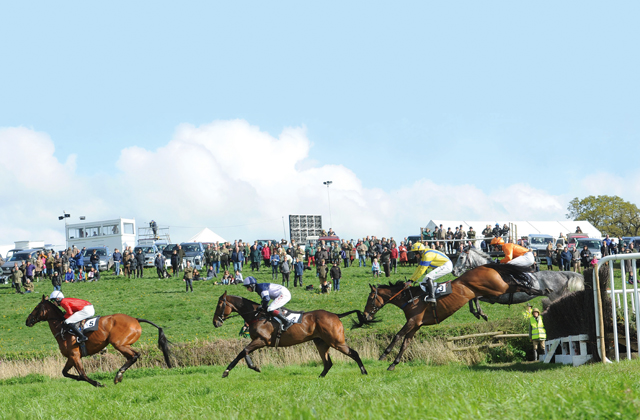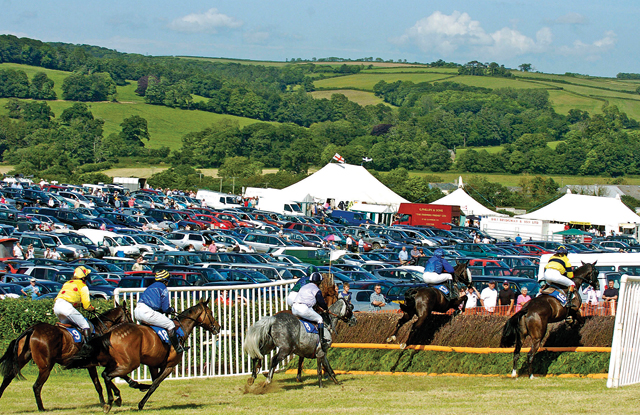Despite modernisation, the amateur sport of point-to-pointing still holds true to its foundation in hunting, reflects the Corinthian spirit and offers a great family day out. With the season getting under way, Brian Armstrong reports.
Point-to-pointing, the muddier amateur arm of steeplechasing that remains closely allied to the hunting field, is still recognisable as the dashing sport first enjoyed by soldiers, dukes, young blades and farmers’ boys some 140 years ago. Despite a significantly more professional approach to safety, fitness and qualifications these days fences are standard brush rather than built of local materials, horses are far more expensive, jockeys weigh far less and are more accomplished and trainers can actually make their living from what used to be a farmer’s hobby the local hunt’s annual point-to-point remains a hugely enjoyable family day out. Children can roam safely free-range, dogs are welcome (on leads), betting is fairly homespun and the picnic is still king.
Whether it’s a freezing February day on Salisbury Plain think whisky mac, sausages in a Thermos and upturned collars or an Easter Monday in Cornwall picnic rugs, beer tents and cold-beef sandwiches—point-to-pointing, often in glorious rural settings, with hunt staff acting as loose-horse catchers and flat caps the uniform, still bears more than a passing resemblance to the way 20th-century sporting artists Snaffles and Munnings depicted it (apart from the cars).
The sport originated in Ireland from cross-country chases in which horses were raced from point to ascribed point in the parish or from steeple to steeple. In 1752, a Mr Edmund Blake is said to have challenged his neighbour, a Mr Cornelius O’Callaghan (amateur jockeys are still titled Mr), to race some 4½ miles across country from the church at Buttevant to Doneraile church in Co Cork, jumping any obstacles stone walls, hedges, ditches and gates—that lay in their way. Keeping the church steeple in sight (hence the term steeplechasing, used for National Hunt racing) enabled both riders to see the finishing point.
The first race to be billed as a ‘point-to-point’ like most equestrian sports, it was begun by the military didn’t come about until 1874, when the 9th Queen’s Royal Lancers staged a contest in Yorkshire. Nowadays, all point-to-point meetings are organised by hunts or hunt clubs and horses qualify by doing at least four days’ hunting in the current season. Similarly, all the amateur jockeys need to gain a qualification certificate from the Point-to-Point Authority (PPA).
 There are more than 100 courses throughout the UK, many of which are located in picturesque parkland settings surrounding great country houses, such as Garnons in Herefordshire, where the grounds were laid out by Humphry Repton; Friars Haugh in the Scottish Borders, which is overlooked by Floors Castle, seat of the Duke of Roxburghe; Berkeley Castle in Gloucestershire; Tabley Hall in Cheshire; Flete Park in south Devon; and the National Trust-owned Holnicote Estate on Exmoor in Somerset.
There are more than 100 courses throughout the UK, many of which are located in picturesque parkland settings surrounding great country houses, such as Garnons in Herefordshire, where the grounds were laid out by Humphry Repton; Friars Haugh in the Scottish Borders, which is overlooked by Floors Castle, seat of the Duke of Roxburghe; Berkeley Castle in Gloucestershire; Tabley Hall in Cheshire; Flete Park in south Devon; and the National Trust-owned Holnicote Estate on Exmoor in Somerset.
Prize money remains modest, although often accompanied by a bottle of whisky, a bag of horse feed or a set of antlers; it’s the sheer thrill and personal satisfaction that count. Leading National Hunt trainers Philip Hobbs and Paul Nicholls, who have won millions between them, can often be spotted having a busman’s holiday at a Sunday point-to-point in which their daughters are riding. Leading bloodstock agent David Minton and world number one eventer William Fox-Pitt are also regulars.
Those who adore it come from all walks of life, including the Royal Family, who have supported point-to-pointing for a century. The Duke of Windsor rode 13 winners and Braes Of Mar provided the Queen Mother with the last of her 450-plus winners on the track in the 2002 VWH members’ race, before carrying her daughter’s colours in three races. The Princess Royal’s Willowpattern won at Larkhill in 2009, trained by her daughter, Zara Phillips, who campaigned a string of 10 pointers in 2014, including Badbury Rings winner Calusa Comet.
Robert Waley-Cohen, chairman of Cheltenham racecourse and owner of 2011 Gold Cup winner Long Run, credits point-to-point-ing for his entry into racing. His proudest moment in the sport came last May, when he saddled four winners from four runners, all ridden by his son, Sam, who runs dental practices, at their local Warwickshire hunt meeting at Mollington, Oxfordshire.
‘Everything stems from my first race ride near to my Exmoor family home in 1974,’ says Robert. ‘I derived enormous fun from being able to play as a poor participant. Nowadays, I love the informality and friendliness of the day. It’s a seriously good sport, everyone has a good chance of success and it’s a great training ground for owners, trainers, riders and officials. It’s wonderful to see future superstars Gold Cup winners See More Business, Cool Dawn and Best Mate all started in point-to-pointing.’
Charlotte Budd (née Brew), who, at the age of 21, became the first woman to ride in the Grand National, in 1977, caught the bug after her parents bought her Barony Fort for £1,000 for her 18th birthday.
‘I trained him myself. Everyone helped and I learned on the job,’ she explains. ‘He provided my first winner 40 years ago, won the East Essex hunt race four years out of five and finished fourth in the Aintree Fox-hunter, which qualified us for the National, where we got as far as the 26th fence. It was just fabulous to be involved.’
Mrs Budd now combines training two pointers with running her own catering business at Enmore in Somerset. ‘I love the camaraderie and us small producers love beating the big yards.’
Doing a night shift driving a milk-collection tanker to farms all around Cumbria enables Wigton farmer Mark Hughes to train his horses, such as Special Portrait, a winner at Cheltenham’s prestigious Hunter Chase Evening in May 2012. ‘I start my shift at 4pm and get home from work between 2.30am and 4am, so my wife, Denise, and I train the horses in the mornings and early afternoons,’ explains Mr Hughes. ‘
I’ve been mad keen on hunting and racing since my mother, who died when I was seven, insisted my father taught me how to ride. We don’t have much time for anything else, but we put our hearts and souls into the horses.’
For Drew Holmes, the point-to-point world provides a welcome distraction from his high-pressure job overseeing international sales, direction and product placement for fashion designer Nigel Cabourn. ‘The beauty of pointing is that it gives an amateur like me the opportunity to be part of the racing world,’ says Mr Holmes, 31, who owns, trains and rides four horses in Northumberland. ‘My work precludes me from doing it on a full-time basis, although it obviously helps fund my interest. Riding over fences at speed is a huge thrill and we always have a good picnic, drink and party afterwards—it’s Jägerbombs if we win.’
10 unmissable meetings
December 14
Ratcheugh Racing Club, Alnwick, Northumberland
Enjoy free entry at this meeting, situated on old turf with sweeping views of the coast
February 8
Combined Services, Larkhill, Wiltshire
Features the classic Coronation Gold Cup, first staged in 1953 in the presence of The Queen, after whom the permanent hospitality complex is named. A big course and a magnificent spectacle, but it can be draughty
February 22
Countryside Alliance Club (Wessex), Badbury Rings, Dorset
Includes a country fair and children’s activities as well as racing. The beauty spot is overlooked by the Badbury Rings Iron Age hill fort, part of the National Trust’s Kingston Lacy estate
March 7
Brecon & Talybont, Llanfrynach, Brecon
An old-fashioned pointing environment—two of the fences have drop landings at the foot of the Brecon Beacons, which usually attracts large fields
March 7
Duke of Beaufort’s, Didmarton, Gloucestershire
Popular meeting on the Badminton estate with myriad trade stands and a 10-race card that attracted more than 100 runners last year
April 4
Kimblewick, Kimble, Buckinghamshire
This Easter Saturday fixture draws a massive crowd to a traditional course that celebrated its centenary in 2012
April 18
Chaddesley Corbett, Worcestershire
Features the Lady Dudley Cup men’s open, first run in 1897 and probably the season’s most prestigious race. A top-class course with fine all-round viewing
May 3
Fernie, Dingley, Northamptonshire
The four-mile Fernie Gold Cup is always a race to savour. It’s a long climb back to the enclosures, but the natural grandstand it offers is arguably the best viewing in the country
May 31
Exmoor, Bratton Down, Devon
The undulating cambers on this moorland course 1,000ft above sea level can change fortunes abruptly. This meeting retains a West Country flavour at the same time as attracting classy title-chasing entrants from up country
June 13
Torrington Farmers, Umberleigh, Devon
Racing tends to take second place at this end-of-season fixture, where a party atmosphere prevails
For a full list of fixtures, visit www.point-to-point.co.uk or telephone Talking Point for updates on 09068 446061

Top 10 National Hunt meetings
We round up the top 10 National Hunt meetings, guaranteed to get pulses racing.

How to play polo
Paula Lester has a polo lesson at the Beaufort Polo Club.

Bring on the dancing white horses
The Spanish Riding School of Vienna have been dazzling audiences for almost 450 years. This autumn, they will be joined





